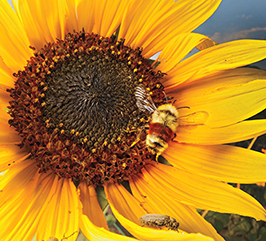
Audubon Adventures

Activities
 Activity 1
Activity 1
Pollination Demonstration

 Teacher-Led Classroom Activity
Teacher-Led Classroom Activity
Science/Art/Writing
How does pollen travel from flower to flower?
Objective:
Students make and use paper flowers and other supplies to dramatize the process of pollination.
Students will need:
- Tissue paper (various colors), cut into 8”x8” squares (3-5 sheets per student)
- Twist ties
- Empty water bottles or tall plastic cups (at least one per student)
- Chalk dust
- Small beads (such as seed beads)
Suggested time:
One class period
What to do:
- Ask students to tell you what they know about pollination. Together, make a list of animals that pollinate plants. Summarize the discussion by describing how bees, butterflies, moths, hummingbirds, bats, and other animals carry pollen from flower to flower. Tell students they will be making flowers that will be used in a pollination activity.
- Provide students with 8”x8” sheets of tissue paper—about 3-5 sheets per student. To make a flower, students should stack their paper neatly then pinch the stack in the center and twist to hold the sheets together. Secure the bottom with a twist tie, then fluff up the sides to form a flower shape.
- Have students place their flowers in the containers. Drop a few beads into the center of each flower. Place half of the containers in a “flower patch” on one side of the room and half in a patch on the other side of the room. Then dust the flowers in one of the patches with chalk dust.
- Each student then takes a turn visiting a flower in the chalk-dusted group and using his or her thumb and pointer finger to burrow inside a flower and extract a bead (which represents nectar). Ask students to notice what happens: Their fingers pick up chalk dust as they reach for the beads. Students then proceed to the patch that wasn’t dusted to extract a bead from a flower there. What happens? Does any dust (pollen) stick to the undusted flowers?
- Afterward, have students write about the demonstration in their science journals.
Photos: Dan Mullen; Clay Bolt.




